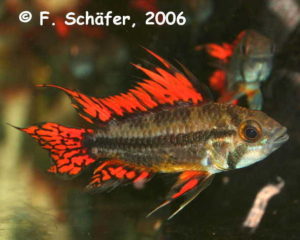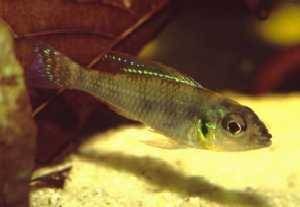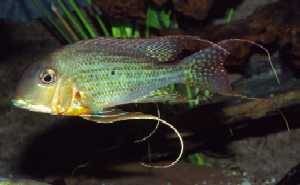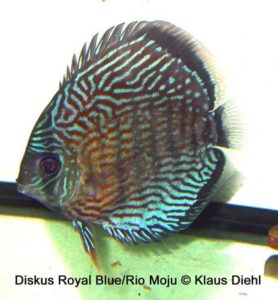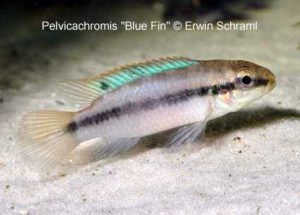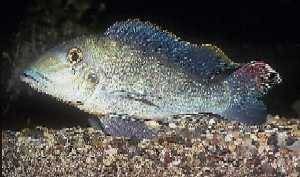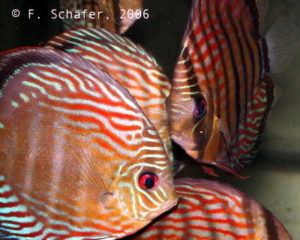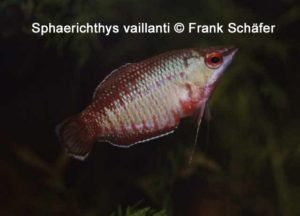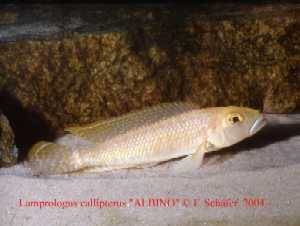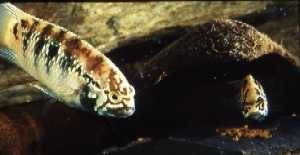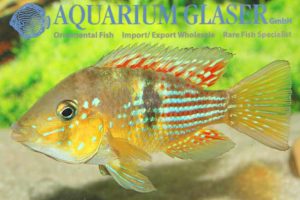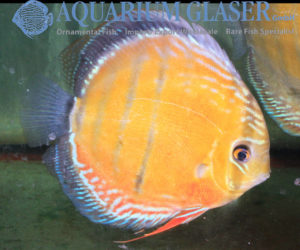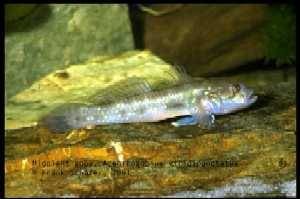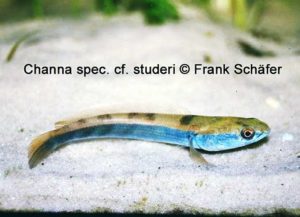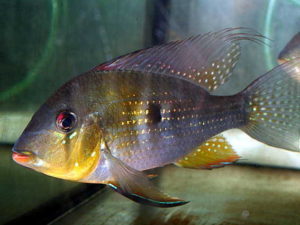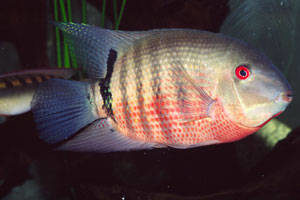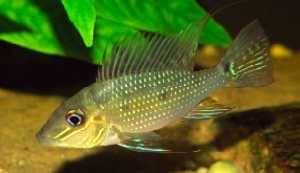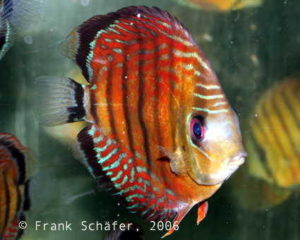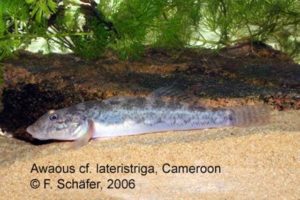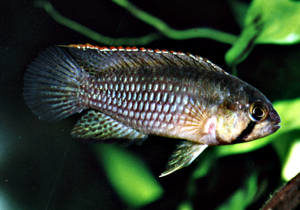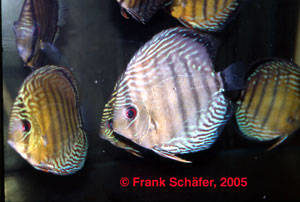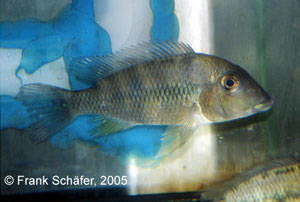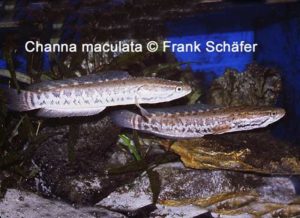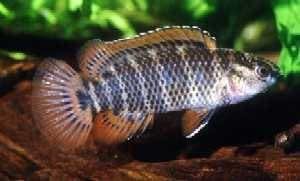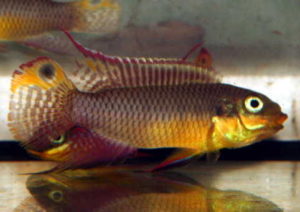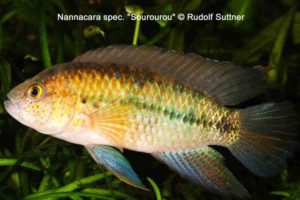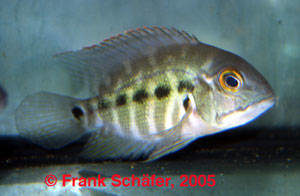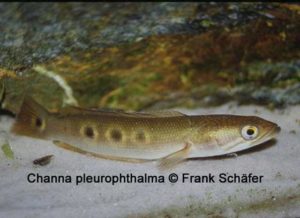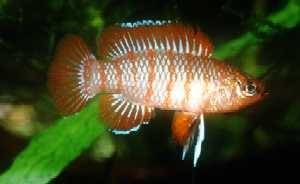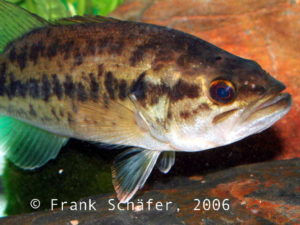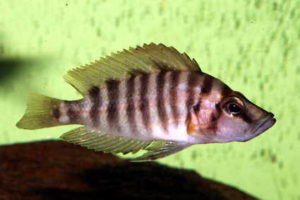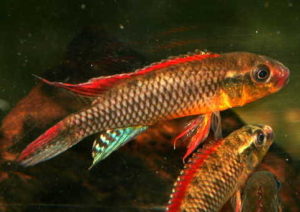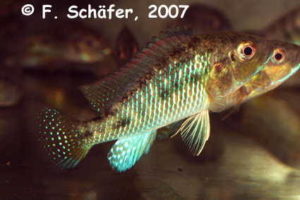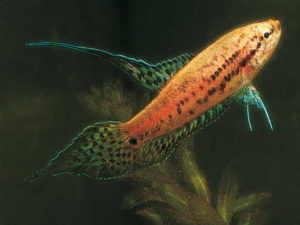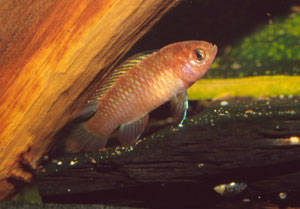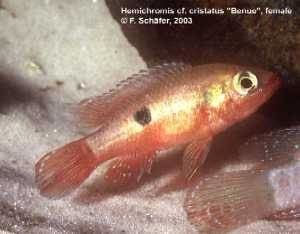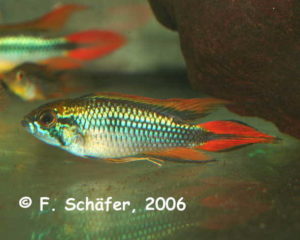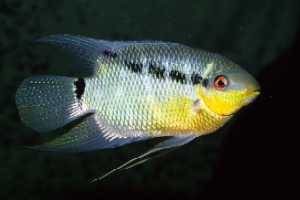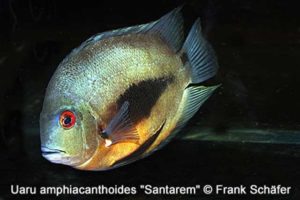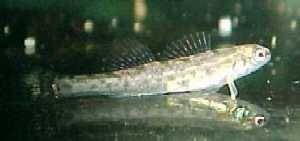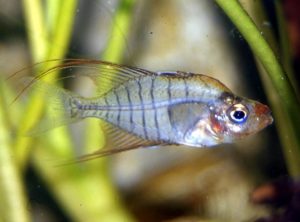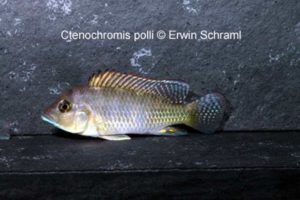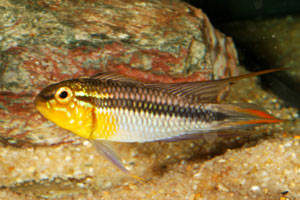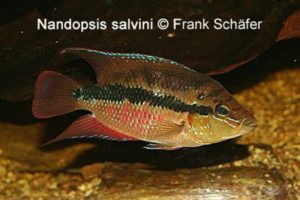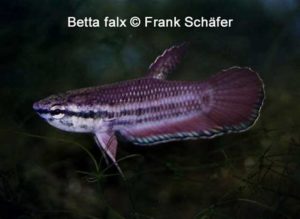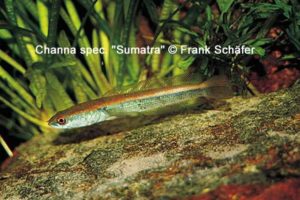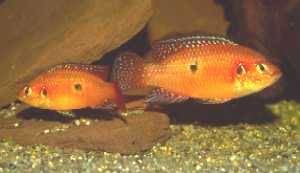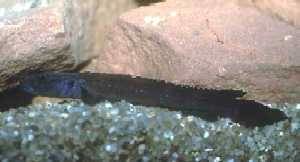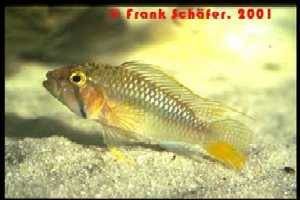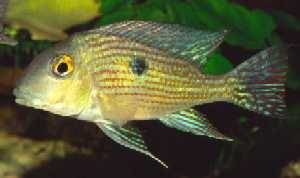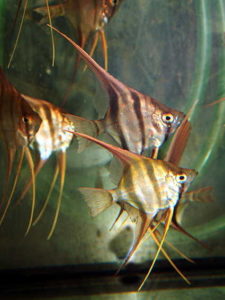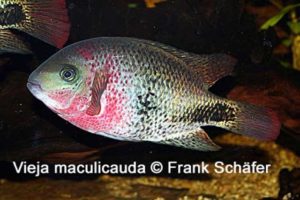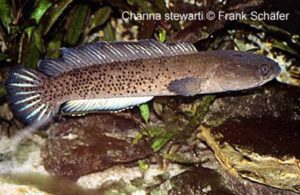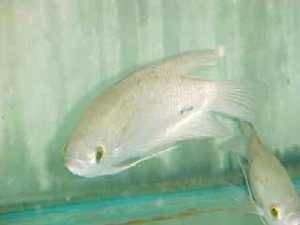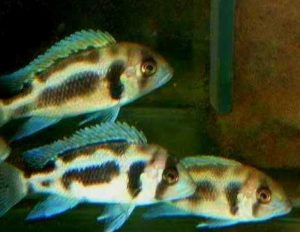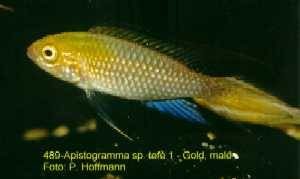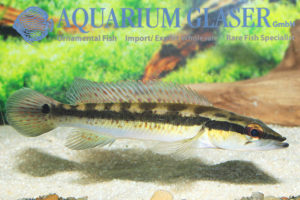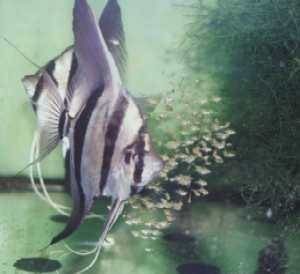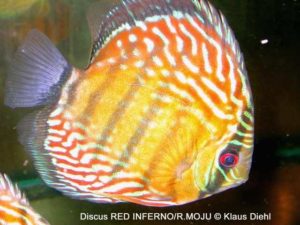December 2006: Freshly arrived: perhaps the most beautiful selection of Apistogramma cacatuoides . Here everything is really correct. The intensity of the colouring, the fins and body form are simply perfect. In addition an outstanding vitality is reached by nearly exclusive feeding with living food. They originate from a german breeder, where a selection over […]
25. Perchlike fishes (861)
-
-
Biotoecus sp. „Tapajos – New“
For quite a while Aquarium Glaser imports this dwarfcichlid regularly from Rio Tapajos in Brasil. This Cichlids, which only get approx. 4-5cm can be kept in pairs in smaller aquariums from 50 ltr and up already. If the aquarium is bigger, a larger group can be brought in, but in doing so a slightly surplus […]
-
Geophagus altifrons
You can surely excellently argue about taste, but the various populations of Geophagus altifrons could justly conquer a solid place among Cichlid lovers. And one of the most beautiful variants might be Geophagus altifrons “Tapajos”. Additionally, G. altifrons is an easy-to-keep cichlid. It requires aquariums with at least 500 ltr. capacity due to its size […]
-
Diskus Royal Blue/Rio Moju
If an increase of beauty and charisma of the at 01.02.06 introduced Diskus variant Red Inferno/Rio Moju is still possible, then by the Royal Blues originating from the same river. When first seeing these fishes I remembered the headline of an old “aquarien magazin” article. In January 1972 Eduard Schmidt Focke a famous german discus […]
-
Pelvicachromis spec. „Blue Fin“
November 2005: From Guinea the import of a still undescribed Pelvicachromis species surprised us. This species seems to mediate within the genus Pelvicachromis between P. roloffi and P. rubrolabiatus, since it carries characteristics of both species. Particularly the name giving bright blue-green dorsal fin of females is noticeable. Maintenance in pairs is appropriate, in larger […]
-
Retroculus lapidifer
To take sensibly care of Retroculus lapidifer, which comes from Rio Tocantins/Rio Araguaia catchment area, you should own quariums with a base of 150 x 60cm minimum, as this species can grow very big (25-30cm). But despite its size you should not socialize it with aggressive cichlids, because it has only a certain self-assertion among […]
-
Diskus Semi royal, Rio Moju
Like the introduced before Discus from the same area (Rio Moju) the “Semi Royal” variant shows a strong red coloration at the seam of their body and their fins. With them the wave pattern is nearly continuous distributed over the entire body. (Photo F. Schäfer, Text K. Diehl)
-
Sphaerichthys vaillanti
Sphaerichthys vaillanti is probably the rarest and most desired species of the Chocolate Gouramies. Their origin is Kalimantan the indonesian part of Borneo. Since they are black water inhabitants, the water equivalents should be adapted in the aquarium to it. This species does best in peat filtered water. Water must be changed often, and a […]
-
Lamprologus callipterus ALBINO
August 2004: Now available: Lamprologus callipterus ALBINO. After several years, one of our breeder was successful in breeding this species. We have this fish for the first time in stock. You will find here more details soon.(Photo F. Schäfer, Text K. Diehl)
-
Nannacara adoketa
In 1993 Kullander & Prada-Pedreros described Nannacara adoketa. The species name of these cichlids relates to the unexpected occurrence in Rio Negro in Brasil. Full-grown males can be easily distinguished from the smaller females, which additionally are stronger coloured than the males. The German name describes the special colouring of these dwarf cichlids. For the […]
-
Gymnogeophagus meridionalis
If you search for a Cichlid for a society aquarium (120 l and up), G. meridionalis is almost unrestricted recommendable. Being a all eatingfish, it accepts every imaginable food, getting only approx. 10-12cm it is not growing too big and it also shows really beautiful colours. Besides it is not choosy regarding the water condition […]
-
Diskus „Nhamunda rosé”
Nhamunda Rosé is the trade name of a strain of the brown discus Symphysodon aequifasciatus axelrodi originated in the Rio Nhamunda (northern influent of Amazon, west the city Alenquer). Now again some Nhamunda Rosé are available. Characteristic for this variety is the partially laminar high red part of the brown primary colour. Thus they are […]
-
Acentrogobius viridipunctatus
This magnificent goby, it´s scientific name is Acentrogobius viridipunctatus, has now been successfully imported from India for the first time in greater numbers. The species attains a length of maximum 15 cm. Fully grown males have a very thick skull. In breeding mood, the fish become complete black in base colour, on which the emerald […]
-
Channa cf. studeri
April 2006: From the here pictured Channa species we can offer some youngsters. What species they are could so far not be clarified, but some characteristics refers to a proximity to Channa studeri. If this classification applies, the fish belong into the form circle of Channa micropeltes. C. micropeltes represents the largest Channa species with […]
-
Acarichthys heckelii
January 2007: At present we can offer particularly beautiful Acarichthys heckelii from the region around Santarem. These fish are characterised by an intensive yellow colouring of the body. It forms a beautiful contrast to the red eyes and their magnificent fin rays. Acarichthys heckelii has a large area of origin along the Amazon and the […]
-
Heros severus
Despite the fact that Heros severus is the type species of the Heros genus, this species is the most uncharacteristic representative of this group. This is mainly caused by its reproducing behaviour, which is mouthbreeding and untypical for Heros, because they are all substrate breeding. Also the coloration is different from the other members of […]
-
Satanopera acuticeps
Normally the durable care of Satanopera acuticeps is only possible in soft and sour pH-value. But as it was finally successful to breed this eartheater inside the aquarium, it could be that the bred ones are easier to keep and even easier to breed. So far the breeding was possible furthermore only in soft (< […]
-
Diskus „Red Inferno/Rio Moju“
In the following pictures you see some impressions from our discus installation. Seldom could we offer a so large selection on magnificently coloured, perfectly acclimatized Discus. The animals originating from different areas are even in our facility hardly to exceed in colour splendour. Since all of them attained full growth, breeders can fast extend their […]
-
Awaous cf. lateristriga
From the coastal ranges of the western Africa between Senegal and Angola originates the freshwater goby Awaous lateristriga. The animal introduced here reminds strongly of this species, whether it is identical to it could yet not be determined. With an overall length of approx. 30 cm Awaous lateristriga belongs to the larger gobys. In their […]
-
Nannacara sp. Essequibo
This fish was caught in October 2001 in a blackwater-river nearby Rockstone/Guyana. It is a peaceful fish which only grows up to 60mm. The males are more elongate than the females and have clearly visible spots in the dorsal and caudal fins. Water of following parameters was used for breeding and keeping them: 5°dGH, pH […]
-
Diskus „Wild Lago Inanum“
This very beautiful discus fish is traded as well under the name „Semi Royal Blue“. Wild caught discus fish are just beautiful! It is remarkable that still new wild type varieties are found and imported. Wild caught discus fish will not be feeling themselves well if not kept under optimal conditions. This malcontent will be […]
-
Geophagus crassilabris
Very large animals, up to 20 cm, came to us from Colombia. These beautiful fish came as well from the Rio Chacu. These eartheaters live in nature in a habitat of moderately flowing streams and rivers. Remarkably for this group of eartheaters is the way they breed their eggs, not as normally in the throat […]
-
Channa maculata
Channa maculata is a snakehead which origins of the border area of China and Viet Nam. It is there very common and offered on markets in large numbers, naturally as a food fish. In their habitat C. maculata lives in ponds, lakes and ditches, usually over sandy or muddy bottoms. With a final size of […]
-
Badis corycaeus (formely: sp. Putao)
This new, brown-red Badis was imported from the borderland of Myanmar and China. They can can be kept even in cooler temperatures and are easily satisfied. Also bred ones are already available. (Photos & Text D. Bork)
-
Pelvicachromis taeniatus „Lokundje“
From Pelvicachromis taeniatus are numerous variants and local forms existing in the western parts of Africa. One of the most beautiful variants is surely Pelvicachromis taeniatus „Lokundje “(a river in the south of Cameroon). At the moment we can offer very beautiful breds from the same breeder as the already introduced Apistogramma agassizi „Fire Red […]
-
Nannacara spec. -Sourourou-
From the Crique Sourourou in French Guyana originates this beautiful new Nannacara variant. We are pleased to be able to offer some offspring to you. According to information of an experienced Nannacara specialist their maintenance is unproblematic, even in middle hard water. The breed however succeeds only in soft and sour water according to their […]
-
Hoplarchus psittacus
This, by specialised hobbyists of large South American cichlid, well known species is only very rarely offered to the public. Our animals were imported from Columbia. The best way to take good care of these beautiful cichlids, which can grow up to 40 cm, is to keep them in large fish tanks with plenty of […]
-
Channa pleurophthalma
Channa pleurophthalma (Ocellated Snakehead) inhabit the lakes and rivers of southeastern Sumatra; Kapuas and Barito basins of Kalimantan. The colouring which can be seen on the young fish illustrated here changes with increasing age to iridescent, metallic blue. C. pleurophthalma can reach an overall length of 40 cm and requires a large aquarium (> 150cm). […]
-
Dario dario
This species, which became well-known as Badis sp. SCARLET is still enjoying great popularity. This dwarf badis can be kept very well along with dwarf rasboras. It is is quite easy to keep and to breed, which was succesfully done several times already. (Photos & Text Dieter Bork)
-
Tahuantinsuyoa macantzatza
The unpronounceable from the Incas empire. So an article about Tahuantinsuyoa macantzatza the Inca Stone Fish could be titled. After fearing over years that they had become extinct, we succeeded to import a larger number of them at the beginning of 2003. For the first time we can offer now both: very beautiful wild caught […]
-
Micropterus salmoides
Something special for your pond. The Largemouth Bass originates from the eastern part of the United States where they occur from the Canadian border down to Mexico. In the meantime they were spread in numerous countries as game fish and can therefore be found also in Europe. They prefer quiet, well warmed waters without a […]
-
Altolamprologus compressiceps
From the shores of lake Tanganjika orgins (Alto)lamprologus compressiceps. There the about 13 cm long getting fishhunter inhabits the detrital zone, which it roams on search for food. When a prey is seen it approaches in slow motion, near the booty it speeds up and catches the victim. Because of its strong lateral flattening it […]
-
Nanochromis sp. „Lezas“
With Nanochromis sp. “Lezas” we can offer a further highlight of German bred fishes. As at the before introduced species this dwarf cichlid is hardly to be exceeded in colour and quality. Particularly noticeable is the strong red colouring of the dorsal – and the upper parts of the caudal fin. In dark, peat-coloured water […]
-
Pseudocrenilabrus philander
May 2007: From the Congo we received Pseudocrenilabrus philander. The fish originate from the upper parts of the Congo river (Lualaba). Their area of circulation covers nearly the entire southern Africa, where they are to be found in practically all types of waters. As mouthbreeders in the female gender their courtship and broodcare run after […]
-
Malpulutta kretseri
September 2006: As German breds we can offer Malpulutta kretseri. These preciousnesses are very rare in the wild and therefore strictly protected in their homeland (Sri Lanka). There they inhabit soft and sour waters and therefore their keeping in aquaria can be somewhat difficult. Small, dimly lit species tanks with a lot of shelters are […]
-
Dario hysginon
Compared with Dario dario this species is hardly known by the general aquarists, although the males who obtain and guard their territory are looking very beautiful. Although they do not display the coloration like D. dario, they definitely show the same intense red colour. Unfortenately D. hysginon only shows his full colour when he is […]
-
Hemichromis cf. cristatus „Benue“
This beautiful cichlid comes from the Benue-river. At least the females grow up to 5cm, the males reach their maximum size with 7cm. Among themselves they are peaceful and they also can be kept with other fish. But there is a slightly rough behaviour, which is typical for all red cichlids. But much less than […]
-
Apistogramma agassizi „Super Red“
Another highlight in breeding effort presents Apistogramma agassizi “Super red”. It’s color allocation strongly recalls wild caught “Red tailed agassizis”, however all colors are evidently more intense toward wild caughts. Particularly the high red proportion and also the metallic body brilliance could considerablely be raised through a strict selection of the breeded species. (Photo F. […]
-
Mesonauta insignis
This cichlid, which is growing up to approx. 20cm is living along the catchment area of the Orinoco, whereit mostly lives in slowly flowing or even standing waters. You often find it right in front of the shore, where it inhabits the upper water layer. Regarding the nutrition M. insignis is totally uncomplicated, because these […]
-
Uaru amphiacanthoides -Santarem-
At present we can offer this magnificent variant of Uaru amphiacanthoides originating from Santarem. The fish impress by their metallical resplendent body and the cherry red eyes. All Uarus are expressed plant lovers. Beside a meaty nutrition vegetarian food should be offered. The food spectrum is large, almost all fruit and vegetables are accepted and […]
-
Micropercops swinhonis
One of the most beautiful new fish species of 2003 is this goby, which is rather widely spread in China, Korea and Japan. Already in 1873 Günther described it under the name Eleotris swinhonis of Shanghai, China, but it made its way to our tanks only now. It can reach a maximum size of approx. […]
-
Etheostoma fusiforme
October 2003: This week we received a limited number of Etheosoma fusiforme. These goby-like perches are also called Darters and originates from North America. Darter males inspire during the courtship with beautiful colors. During the summer months this species can be held also in the domestic garden pond. (Photo F. Schäfer, Text K. Diehl)
-
Gymnochanda filamentosa
This glass perchlet is a rare inhabitant in German aquaria. This species originates from Malaysia and Singapore. The male from G. filamentosa is easily distinguished from other Chanda species by the elongated fin rays of the dorsal and anal fins. The maintenance of these fish is not very complicated and a bit of salt added […]
-
Ctenochromis polli
Ctenochromis polli occurring in the Congo River belongs to the rather rarely kept cichlids. Despite their body length of maximally 11cm they should not be kept in too small aquariums (100cm). The males are quite aggressive and pursue the females and suppressed males. They need sufficient hiding places, therefore the interior arrangement of the aquarium […]
-
Apistogramma agassizii ,,Abacaxis“
The fish in this picture shows the beautiful A. agassizii colour morph from the Rio Abacaxis, which lies in the middle part of the Amazon River in Brasil. Recently a number of new varieties are introduced to the hobby, originating from breeding as well as import of local colour morphs. We can only hope that […]
-
Nandopsis salvini
December 2006: At present we can offer a very beautiful, strongly red coloured variant of Nandopsis (Cichlasoma) salvini to you. They origin from South Mexico, Belize and Guatemala, where they live in to the Atlantic ocean heading streams. Like most Central American cichlids they are very easy to keep in middle hard water at pH […]
-
Betta falx
Betta falx, belonging to the Betta picta form circle, was scientifically described 1998 by Tan and Kottelat. Their origin is the central part of Sumatra, where it occurs in dense overgrown, nearly standing waters. The water conditions at the habitat (pH 5.7, GH 0 – 1, KH 0 – 1) do not have to be […]
-
Channa spec. „Sumatra“
About this Channa species we do not know too much. It originates from Sumatra and we are not able to classify this species on the basis of its youth colouring. Probably their final size lies within the range of 30 – 40cm. If one is ready to slur over its enormous appetite and decides for […]
-
Hemichromis sp. Bangui
Red Cichlids of the species Hemichromis are generelly regarded as aggressive, but this prejudice is based on past years, when 160 ltr tanks were considered to be bathtubs and you mostly had to be satisfied with 60 ltr aquariums. To keep them in pairs, an aquarium of this size is in fact sufficient for Hemichromis […]
-
Teleogramma depressum
This rapid inhabitant from the lower Congo catchment area, which grows up to 10cm is generally regarded as the worlds flattest cichlid. At first sight it it looks like the little more known T. brichardi, but T. depressum – as the species name already tells – is distinctly more flattened, which you can especially see, […]
-
Apistogramma sp. MOUTHBREEDER
It was quite a big surprise to find a mouthbrooder in the well known genus Apistogramma ! The peruvian species is not yet described scientifically. It grows to a size of about 8 cm, which is pretty big for a “dwarf cichlid”. This species is still quite rare in the trade and thatfor pretty expensive.(Photo […]
-
Geophagus sp. „Pindare“
Among the “Eartheaters”, species Geophagus, G. sp. “Pindare” is one of the most recommendable ones. Growing up to approx. 15cm only, it stays rather small and also shows a beautiful marking with red and blue lines on its flanks. The care of this species is really quite simple, because it does not care about the […]
-
Pterophyllum altum
The new season began, Pterophyllum altum (Orinoco) is available again. Deep Angels can reach 20cm length and up to 35cm in height. This has to be considered with the tank purchase, it should have a height of at least 70cm. A decoration with large bogwood, provides structure and retreat possibilities for them. Since they are […]
-
Vieja maculicauda
Vieja (Cichlasoma) maculicauda the Blackbelt Cichlid is one of the larger Central American cichlids. Males can reach about 35 cm overall length. According to its size one needs voluminous aquaria, where their interesting social behaviour can be observed. In their distribution area (Atlantic slope, from the Usumacinta River drainage in Guatemala to the Chagres River […]
-
Channa stewartii
This often under the name Channa cf. barca traded Snakehead originates from the Indian province Assam. C stewartii can reach a length of 30 cm and as predators they should kept together only with fishes whose length exhibits at least 2/3 of their body length. Beside living and dead fish they accept food as insects, […]
-
Osphromenus exodon
Even this fish looks like the common gourami, it is really something special & rare. As far as we know, this species was never before importet to Germany. When they have the size of about 30-40cm, they turn their lips inside out and show many small white teeths. Unfortunately this stadium is only shown in […]
-
Cyphotilapia frontosa var. „DARK BLUE HORIZON“
March 2005:New on our list and absolutely rare: Cyphotilapia frontosa var. “DARK BLUE HORIZON”. We are proud to present these only in extremely small number existing variant of the well-known Cyphotilapia frontosa. Beside the remarkable longitudinal striation the animals are characterised by a very intensive blue. Since so far only very, very few animals are […]
-
Apistogramma sp. Tefé 1 – Gold
The first golden animals were found among a bred shoal of young, approx. 14 days old Apistogramma sp. Tefé 1. From them a breeding phylum for further generations of Golden Apistogramma developed. Their growth is plainly slower than the growth of the normal Apistogramma sp. Tefé 1 and their breeding is generally more difficult. Their […]
-
Crenicichla spec. ITAPEMIRIM
We received this extremely colorful species of Crenicichla from the southeastern part of Brazil. In adults the sexes can be distinguished quite easily. Females (see main photo) have an ocellus in the dorsal fin which is missing in males (see additional photo). Moreover, in males the deep red spots are scattered over the body, whereas […]
-
Pterophyllum altum german bred
November 2003: Lately we received German bred Pterophllyum altum. It is worth mentioning that this was a natural brood, eg both parent took care for eggs and the young. Even spawning of the Altum Angel is a remarkeble event. This species tends to get panic attacks when the fish is fully grown. Thus they tend […]
-
Discus „Red Inferno/Rio Moju“
Only one example of at present in extraordinarily good quality arriving Diskus is the “Red Inferno” variant coming from the Rio Moju. On their fins and flanks the animals show a strongly red-orange basic colour, which stands in beautiful contrast to the bluish green wave pattern. The icing on the cake are their cherry-red eyes, […]
- « Previous Page
- 1
- …
- 7
- 8
- 9





